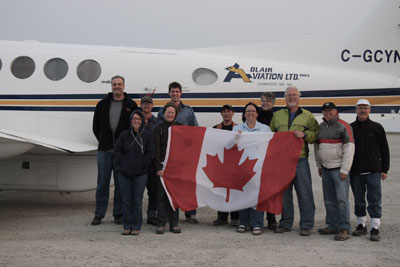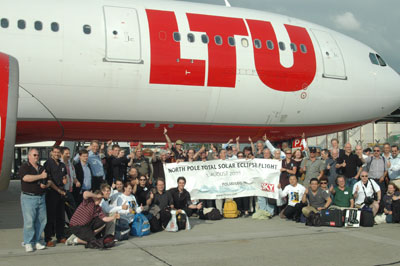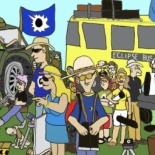 |
www.eclipse-chasers.com Solar Eclipse Chasing in the Air Author: Multiple Last update: Monday, 12-Dec-2016 17:54:02 EST |
Eclipse Chaser
(noun) - Anyone that wants to see a total solar eclipse.  Search Eclipse Chasers Site
Search Eclipse Chasers Site |
Solar Eclipse Chasing in the air
-a list of eclipses observed from aircraft of all sorts.
|
1887 - During the 1887 August 19 eclipse that passed over Russia Dmitri Mendeleef, better known for his work on the periodic table, used a balloon to rise above meteorological challenges and successfully observe the event. - from SEML message #7301 Derryl Barr (4) - NY Times article |
||
|
1912 - Nature: May 2, 1912, p. 220 - Location: three-quarters of a mile to the north-east of the village of Chavenay. Time: After first contact at 10h 48m. "There was scarcely a breath of wind and a balloon which was silently making captive ascents ... twice the whir of the Gnome engine was heard when a biplane and a monoplane came over in our direction from the south ... " p 222. French observations of the eclipse: "M. Salet's report would place the central line about half-way between [the "Conaissance des Temps" line] and that given by the American Ephemeris." This was confirmed by observations made from a dirigible, and a captive balloon, by M. M. Fournier and Bourgeois near St. Nom-de-Breteche." - from SEML message #7309 Bob Morris(4) Societe Astronomique, pp. 234-248, 1912 - By Camille Flammarion (Translation from French by LRM) p. 240 "A balloon dirigible, having on board Admiral Fournier and Colonel Bourgeois permitted good perception of the moon's shadow at a speed of 800 m/sec ... From a captive balloon near Saint-Nom-de-la-Breteche, Captain Dupic made analogous observations which confirmed those made from the dirigible." - from SEML message#7309 Bob Morris(4) The Observatory of Paris had the Globule balloon aloft for the 17 April 1912 hybrid eclipse. Pictures of the hybrid eclipse can be viewed at Xavier M. Jubier page. - from SEML message#7375 Xavier M. Jubier(4)
| ||
|
1914 - Prof. David Todd of Amherst College travelled to Russia to observe the eclipse from an aeroplane. His plan was to chase the shadow in the airplane at 120 miles per hour. Unfortunately, the war in Europe thwarted his attempts to get there. New York Times article reference that says his plan was like "chasing the sun" - one of the first uses of the term chasing in regards to eclipse observations. - from Bill Kramer | ||
| 1918 - From the Oct. 19. 1918 issue of Scientific American: If it develops nothing else of novelty, the recent {08 June 1918} solar eclipse can fairly lay claim to be the first astronomical event to be observed from an airplane. Although the flight and observation made at Fort Sill, Okla., were not undertaken with any serious scientific objective in view, it was at least demonstrated that we may eventually look to the aviator for work of value in connection with eclipses. - from Glenn Schneider(1) | ||
| 1919 - Professor David Todd's attempt to view the eclipse of 29-May 1919 from a Navy sea plane. June 30 Brazil, NY Times article | ||
| 1923 - 16 US Navy aircraft deployed along the path at various altitudes (5,500 - 16,500 feet) to determine the centerline location and attempt aerial eclipse photography. Records of all aircraft involved are not available however it is known that a Curtiss F-5-L flying boat did participate and it is most likely that De Havilland DH-4B biplanes were also used. Despite taking 30 photographs none were successful in imaging the eclipse and according to the 1925 Popular Astronomy (33,329) article by F.B.Little: "No valuable results were secured."(1)(2) | ||
1925 - In the quest for a better photographic platform it was suggested that the top of an airship be used, specifically the USS Los Angeles. After consulting with experts in the construction of airships that idea was dropped but the notion to use an airship to ascend above the clouds was a good one.(1) Benjamin P. Cooper (from SEML#7398 (4)) supplied this link from the the airship Los Angeles. A video was obtained by cameras on board the airship. Click here to watch As you can see in the video, the clouds were higher up than the airship.
Joe Rao (from SEML message #7304 (4)) adds the following information ... there were 25 aircraft that went aloft to observe the eclipse. Flying above the clouds, at altitudes varying from 5,000 to 15,000 feet and strung out in a line from New Haven, Conn., to Greenport, RI, fifty men witnessed the eclipse. They all left from the now defunct Mitchell Field on Long Island. One of the aircraft carried Willem Jacob Luyten (1899-1994), a Dutch-American astronomer, who from 1923 to 1930 worked at the Harvard College Observatory. His first-person account of the eclipse from a de Havilland aircraft was carried on the front page of the January 25, 1925 edition of The New York Times. Luyten witnessed the eclipse at an altitude of 10,000 feet over the Long Island Sound shoreline of Connecticut and later noted that one of the difficulties that he had in photographing the totally eclipsed Sun was not being able to see what the frame number in his camera was registering. "I could only snap the shutter, advance the film and hope that my next pot-shot would not end up on the previous frame!" Lastly . . . totality also passed over Toronto, where overcast skies unfortunately prevailed. Aircraft there flew to an altitude of 9,000-feet but were unable to pierce the clouds to get a view of the eclipse. |
||
| 1927 - London Times - June 30th, 1927 edition - from Mike Frost of the SEML(4) "Sealand Aerodrome, near Chester, June 29 - An aeroplane of Imperial Airways, piloted by Captain G.P.Olley, had been specially chartered by The Times in order to observe and photograph the eclipse from above any cloud banks that might intervene, and at a height of 3,000ft., dead on the centre line of totality over Clitheroe, a continuous view was obtained. Our machine was a D.H. 50, with the cabin specially adapted for our purposes, and Captain Olley, one of our most experienced pilots, served us well, especially in the exactitude of his course-keeping at the critical moments. He had mapped out a route to take us over the estuary of the Mersey, past Liverpool to Southport, to view first the scenes on the broad sands. Then, as 6 O'clock approached, the machine swung on to a course up the valley of the Ribble and past Preston to Clitheroe. This enabled my colleague to keep his camera pointed continuously at the sun throughout the critical phases, while I was able to see not only the sun blotted out on a velvety sky of deepest blue, but also the almost more impressive darkness which rapidly swept up and over us from the south-west. During the 20 minutes before the actual eclipse our pilot had searched the sky for the best height to obtain a clear sky, and after climbing to over 5000ft gave us an unobstructed view of a somewhat watery sun, but one which, unfortunately was never so strong as to make it necessary to put on the specially prepared colour screens. As seen from the air the actual disappearance of the sun and the coming of the corona - a thin circle of palest gold in the deep hues of the sky - however important to scientists, left less impression on the mind than that swift descent of unusual night upon the face of the earth." |
||
| 1930 - Attempt by several military organizations to photograph the eclipse at altitude. A very short eclipse (border between annular and total) with a calculated total duration of 1.4 seconds (without limb corrections). US Army Air Force flew two planes at 10,000ft out of the Napa/Sonoma California area while the US Navy flew out of Honey Lake California. The Navy used a Sikorsky PS-3 to transport people and equipment and a Vought O2U-1 equipped with an Akeley motion picture camera to photograph the eclipse shadow. The observations of the approaching shadow aided in providing corrections to the lunar almanac.(1)(2) | ||
1932 - Photograph of small airplane with four eclipse observers. Press photo: New York...Members of an eclipse aerial expedition ready to Roosevelt Field to climb 30,000 feet to photograph the eclipse. Left to right: Aaron "Duke" Krantz, Pilot; Herbert Partridge, Technical observer; Robert Donahue, movie camera operator; and Buck Baron, camera operator. From Joe Rao of the SEML#7304(4) comes this additional note: August 31, 1932 . . . in The Story of the Moon, A popular 1943 book that shows up frequently in used book shops, astronomer Clyde Fisher --the first curator of New York's Hayden Planetarium -- wrote about about observing that eclipse from an aircraft somewhere over Lake Winnipesaukee, New Hampshire. It even included a couple of black and white photographs of the Moon's shadow projected against the sky. Army Air Corp/NGS expedition flew to 27,000 feet to photograph the moon's shadow. National Geographic (Nov)1932,62,581. (1) |
||
| 1945 - Royal Canadian Air Force/Canadian Radio Wave Propagation Cmte. flew four aircraft (Spitfire, Mitchell, 2-Anson) between 17,000 and 34,000 ft with a mission to photograph the eclipse of July 9th with visual and infrared cameras and do spectroscopic/polarization measurements. This was the first spectroscopic observation of a solar eclipse from a heavier than air craft.(1) | ||
1947 - Eclipse photographers in a B-17 bomber. National Geographic photo: Photographing an eclipse inside a B-17 in Brazil wearing pressure suits and seated on air mattresses. Altitude 30,000 feet. |
||
1948 - National Geographic Society secured the use of two B-29 bombers at 27,000 and 29,000 feet observed the annular solar eclipse with a goal to refine ground measurements.(2) |
||
1952 - In Sky & Telescope for July 1952, pages 222-223, is an article titled "Eclipse Observations from a B-29." For the TSE of February 25, 1952, a U.S. Air Force B-29 flew at about 32,000 feet over the Red Sea and Saudi Arabia. It had several experiments aboard for recording sky spectra as well as the zodiacal light. The article says, "Its ground speed was a little over 350 miles per hour, so that the duration of the eclipse was increased from three to about 3-1/2 minutes." - Roger W. Sinnott from SEML(4)Msg#9080 |
||
1954 - Modified Avro Lincoln (four engine long range bomber) to study the outer corona from high altitude. 30,000 feet was used even though the aircraft could operate at 43,000 feet.(1) |
||
1955 - T-33 Jet (two seat trainer) at roughly 600 mph for a totality duration of 12m 15s. The first real eclipse chase by jet!(1) |
||
| 1963 - Douglas DC-8 observations and first use of a gyro-stabilized camera.(1) | ||
| 1965 - Los Alamos Lab flies multi-function telescope imager, photometer, and interferometer used on a Boeing NC-135. The same jet was used by research teams from Los Alamos, Sandia, and Livermore Labs for the eclipses of 1966, 1970, 1972, 1973, 1979, and 1980.(1)(2) | ||
| 1966 - Gemini 12 actually flew through the umbra shadow for the November 12th total solar eclipse over South America. Astronauts Aldrin and Lovell were able to take some pictures through the spacecraft windows. Gemini 12 flew in an orbit ranging from 160.8 to 270.6 km above the Earth making this the highest flying eclipse chase known to date.(1) | ||
Image of painting supplied by Bob Morris of the SEML(4), click on the image to learn more about it and to see a much better view. |
||
| 1974 - Ansett 727 out of Perth, Australia, to see the eclipse of June 20th over the Indian Ocean. Half the seats on the left side of the plane were removed so people could set up their gear. This is the first commercial eclipse flight and was arranged by VIP Tours (more info - see 1974) | ||
1979 - NASA Learjet Observatory, KC-135 Los Alamos, NASA T-38 chase the eclipse across North America.(1) The FAA reported that over 1000 aircraft were in the air over the continental USA while the eclipse was underway. NASA astrophysicist astronauts (then candidates for the program) Sally Ride and Steve Hawley photographed TSE 1979 from a T-38 trainer at 43,000 ft.(1) Don Piccard and Tom Barrow observed from a hot air balloon in Montana in February 1979. Here are links to the Tom's article in May/June 1979 Ballooning Journal. Page 1 * Page 2 |
||
| 1981 - NASA Kuiper Airborne Observatory performs far-IR/sub-mm observations.(1) - Photographs out window of unknown plane near Hawaii | ||
Nov 23 flight over the Pacific Ocean near French Caledonia. Serge Koutchmy and his IAP (Institut d'Astrophysique de Paris) team observed the eclipse from 30,000 ft. From Xavier Jupier SEML#7375 (4) |
||
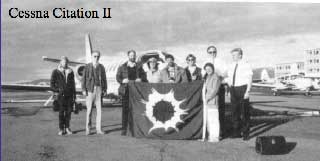 1986 - Flight over the Atlantic Ocean near Greenland in a Citation II. - from Glenn Schneider(1) For a complete write up of how far some will go for just seconds of totality, click here. 1986 - Flight over the Atlantic Ocean near Greenland in a Citation II. - from Glenn Schneider(1) For a complete write up of how far some will go for just seconds of totality, click here. |
||
1990 - Finair DC-9 with eclipse chasers (first commercial eclipse tour by air?) also - Flight over Finland by a French Falcon-20 set up to photograph the coronal for spectral studies. - from Glenn Schneider(1) American Trans Air delayed their Flight 402 from Honolulu to San Francisco for 41-minutes, therby suitably placing them within the totality path where passengers on the sun-facing side of the L-1011 jet airctaft witnessed 73-seconds of totality. - from Joe Rao (4) |
||
| 1992 - Over the South Atlantic in a DC-10 - from Glenn Schneider(1) | ||
| 1995 - MIG-25 80,000 feet, Mach 2.5 for 90 seconds of totality.(1) | ||
1999 - MIG-21 Bulgarian coordinated experiment with ground units to photograph the outer corona - from Dr. Yavor Shopov (Uni-Sofia Bulgaria): "The airplane entered the solar shadow near Ruse city, Bulgaria and traced it over the Black Sea up to the end of the Bulgarian territorial waters... Two equivalent parallel optical systems were mounted in the airplane...Solar corona recorded (at distance over 25 solar radius far from the Sun) ... made from a sky fighter flying at 13,000 m. altitude with speed 1600- 1700 km/h" - what a marvelous eclipse chase! (1) Three Concordes are in the eclipse path but the high altitude of the eclipse above the horizon combined with small windows made observations difficult. Stunning views of the shadow over the Earth but only fleeting seconds of totality as the super-sonic-transports swerved. For many the eclipse viewing was in 10 second intervals. Falcon 900 private jet out of Teterboro, NJ USA. Viewed the eclipse over the Atlantic at 41,000 feet. We were in fact slightly "over the horizon" beyond the tangent point of where the eclipse first hit the Earth, able to see it only due to our altitude despite being beyond the end of the ground track. Totality would have nominally been 48 seconds, but I chose to cut across the centerline following the angled 3-D motion of the shadow cone somewhat, to extend totality to 54 seconds. Unfortunately due to the pilots using their "ETA clock" rather than GPS clock, and a discrepancy between those clocks, we only got 15 seconds of totality, but the upside was extremely long Bailey's Beads and Diamond Ring. - report from John Hopper Hawker Siddely 125 chartered by Leo Metcalfe out of Shannon airport in Ireland. (written report - Eclipse Riders in the Sky) Antonov 2 (biplane) from Les Ailes de l'Europe at 11000 feet over France - pictures and report by Martine & Jean-Paul Godard. Also reported by John Hopper - Dennis DiCicco of Sky & Telescope was one of 3 people in an unknown turboprop around 25,000 feet at the same time. He was with the airplane owner and the telescope optician Peter Ceravolo. They were flying down the centerline of the eclipse. |
||
2003 - Two charter flights over Antarctica: QANTAS Boeing 747-400 ER charter for flight from Australia and Lan Chile Airbus 340 from Chile. Click here for details. - from Glenn Schneider(1) , Klipsi reports: I saw the 2003 ASE May 31 on a commercial (not eclipse charter) flight, NWA 64, from Seattle to Amsterdam, as we were near Iceland (image from video capture) May 31st partial eclipse with Balloon in foreground. - Bonn Germany - APOD June 6, 2003 |
||
2006 - From a hot air balloon in Turkey. YouTube movie, looks like fun! | ||
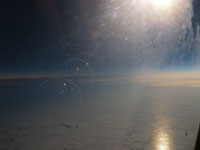 CAUTION: The view from above the clouds is not without difficulties as seen in the image to left (click on image for higher resolution view). Ice, fog, and scratches on the windows distort the view. And the multiple layers of glass can also refract and reflect a lot.
When using a wide angle lens configuration it is important to plan where background lights and internal reflections may occur. The portal for viewing and photographing is quite small, contains multiple layers of variable materials, and was really designed for casual looks and not photography. Of course, those that get lucky and have the right set up can get stunning photos if they really work at it! - photo by Denise Kramer, 2008
CAUTION: The view from above the clouds is not without difficulties as seen in the image to left (click on image for higher resolution view). Ice, fog, and scratches on the windows distort the view. And the multiple layers of glass can also refract and reflect a lot.
When using a wide angle lens configuration it is important to plan where background lights and internal reflections may occur. The portal for viewing and photographing is quite small, contains multiple layers of variable materials, and was really designed for casual looks and not photography. Of course, those that get lucky and have the right set up can get stunning photos if they really work at it! - photo by Denise Kramer, 2008 |
||
2008 - TSE observed from Adlair Aviation King Air 200 near the beginning of the eclipse path over Taylor Island, east of Cambridge Bay, Nunavut, Canada.
Video from eclipse flight (from Stephen Bedingfield) *** | ||
| 2009 - TSE observed over India in a Boeing 737-700 (article) | ||
| 2010 - TSE observed in Airbus over Pacific Ocean for a record 9.5 minutes. Report by Glenn Schneider, Article in Wired magazine | ||
| 2012 - TSE observed from helicopter above clouds over Miallo, near Port Douglas Australia. | ||
| 2013 - TSE observed from Falcon 900B over the Atlantic, and dicey weather conditions from Cessna Grand Caravans over Kenya (video) and report. | ||
| 2015 - TSE observed from commercial aircraft out of various European airports. Dedicated flights were coordinated by Glenn Schneider and Xavier Jubier of the IAU WGSE and the European Air Traffic Control managers. With the exception of some ice on the windows the flights went perfect intercepting the shadow high over the clouds. Aircraft used included Airbus A320-200, Boeing 737, MD-83, and Falcon 7X. | ||
References: (2) Milestones in Airborne Astronomy from the 1920s to the Present (1997 - Wendy Whiting Dolci - NASA Ames Research Center - pub#975609) (3) Jeff Jenner - The Earth Observer, May/June 1995 - Ames Research Center: A complete Service Center for Airborne Earth Observation (4) Solar Eclipse Mailing List (SEML) Yahoo email group of eclipse chasers, enthusiasts, and scientists. Number next to reference indicates message number. - List started by Bill Kramer See also - Eclipse Chasing by Ship |
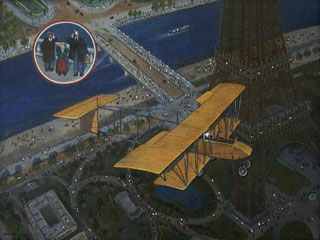



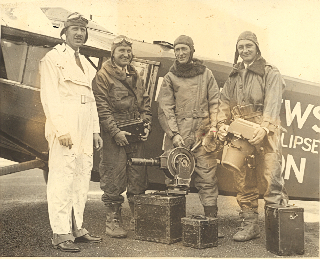
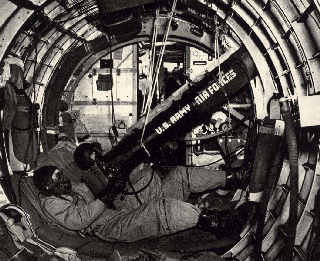
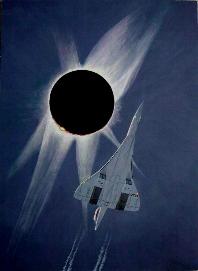
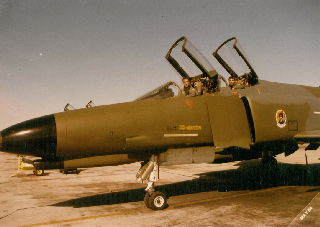 1984 - Evan Zucker of the SEML#7307(4) reports that he was flying an intercept training mission during the May 30th near-total eclipse in a
1984 - Evan Zucker of the SEML#7307(4) reports that he was flying an intercept training mission during the May 30th near-total eclipse in a 